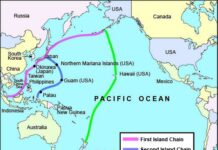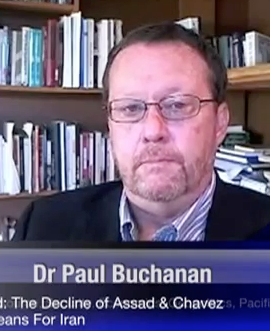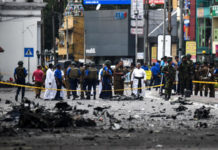Last year the People’s Republic of China (PRC) and the Solomon Islands signed a bilateral security agreement that includes police training and port visits by Chinese security advisors and naval vessels. This includes training in “crowd control” and protection of Chinese investments in the Solomons and opens the door to the possibility of forward basing of Peoples Liberation Army Navy (PLAN) assets in the archipelago. Needless to say, Western governments, including the US, Australia and New Zealand, reacted negatively to the deal (whose terms have not been entirely released), as have some members of the Pacific Island Forum community.
This year, the Australia, the UK and the US formally signed the AUKUS nuclear submarine agreement whereby Australia would first acquire, then manufacture nuclear powered submarines based on US and British attack submarine designs. The PRC and several Pacific Island Forum (PIF) states reacted negatively to the agreement (which may violate the 1997 Treaty of Rarotonga establishing a South Pacific nuclear free zone), although other Western Pacific Rim nations were either muted or supportive in their responses.
Also this year the US and Papua New Guinea (PNG) signed a bilateral security agreement that will allow US forces to operate on and from PNG soil and which includes a significant economic development component as part of the package. More recently, Japan and New Zealand signed a bilateral military cooperation agreement that is focused on joint operations in the South Pacific, initially for humanitarian reasons (such as the recent disaster relief efforts after the volcanic eruption in Tonga, where Japan participated) but opening the possibility of future joint military training and exercises in kinetic operations, especially in the West and SW Pacific maritime security environment. This follows on an intelligence-sharing agreement between Japan and NZ signed last year that allows better Japanese access to the 5 Eyes signals and technical intelligence collection alliance involving the US, UK, Australia and Canada as well as NZ, and which may pave the way for eventual Japanese integration into the alliance. Since intelligence sharing is part of military synergies and interoperability between different armed forces, this sequence of bilateral agreements would seem to be a natural progression in the NZ-Japanese security relationship.
What does all of this have in common? it is part of what might be seen as balance of power gamesmanship between the PRC and various rival powers in the SW Pacific region. Balances of power are, as the name implies, about balancing the power of one or more states against that of other states. These balances involve military, economic and diplomatic power and/or influence projection. Some so-called balances of power are actually not balanced at all and involve the domination by one state of a given strategic arena. This was the case for the US in the greater Pacific basin from WW2 up until recently. Now, with the decline of the US as a unipolar international “hegemon” and the rise of an emerging multipolar world that includes the PRC as a Great Power contender, the Western reaches of the Pacific basin have become a zone of contestation in which US and Chinese influence and power projection compete.
Other balances of power may be between two or more states sometimes operating as partners against common rivals and sometimes operating as sub-sets of a larger arrangement. Most balance of power subsets involve regional subsets of global rivalries.For example, NATO and the Warsaw Pact were European regional balancing vehicles contained within the larger bi-polar balance of power between the US and USSR during the Cold War. The contemporary rivalry between the Sunni Arab oligarchies and the Persian theocratic regime in Iran is a Middle East example of a regional balance of power in which competition for influence and support for armed proxies is part of the balancing game.
 In East and Southeast Asia, several states have joined US-led coalitions in order to balanceout the increasing PRC military presence in that part of the world. The Philippines, Singapore, Malyasia, Vietnam and Thailand, to say nothing of South Korea, Japan and Taiwan, all have bilateral military-security agreements with the US that are specifically designed to help counter Chinese power projection in Western Pacific Rim area of operations (AOR).
In East and Southeast Asia, several states have joined US-led coalitions in order to balanceout the increasing PRC military presence in that part of the world. The Philippines, Singapore, Malyasia, Vietnam and Thailand, to say nothing of South Korea, Japan and Taiwan, all have bilateral military-security agreements with the US that are specifically designed to help counter Chinese power projection in Western Pacific Rim area of operations (AOR).
A way to think about this multi-tiered/multi-faceted geopolitical balancing is to envision as what economists call a “nested” game, i.e. a game or games played within a larger game or games. The largest game sets the broad contours of what happens within it, with smaller games or subsets focused on specific meso- or micro-aspects of the larger (macro) game and with each level of games reinforcing balancing plays on the others. A less academic way is to think of balance of power games as being akin to a Matryoshka Doll with the largest game holding within it a number of smaller subsets that give internal substance to the overall representation.
The action/reaction dynamic between the PRC and rival powers involves a) the attempt to ring-fence the PRC in terms of its power projection in order to limit its capability to influence, via the threat of coercion or otherwise, regional politics; and b) the attempts by the PRC to break out of the corralling project erected against it. Arguments aside about whether the breakout move or the ring-fencing project came first, that is now a fait accompli. The dynamic is out in the open in the South China Sea, where the PRC has abandoned its insular, land-based strategic perspective and announced its maritime presence with its island-building project in international waters and its increased deployments of armed vessels off the coasts of its littoral neighbours as well as out into the blue waters of the West and Southwestern Pacific.
In return, the US has shifted sixty percent of its naval assets to the Pacific (rather its traditional focus on the Atlantic), and moved significant contingents of long-range bombers and fighter aircraft to bases in Guam, Okinawa and in the near future Australia. It has bolstered troop numbers and rotations in places like the Philippines, South Korea and Australia and increased the tempo of joint exercises with a host of regional partners. Likewise, the French have increased the size of their Pacific army and naval fleets (headquartered in Noumea and Papeete, respectively), as well as the number of exercises with Australian and US forces in the SW Pacific. The ring-fencing versus breakout balancing project, in other words, is well underway.
For a podcast discussion based on this post, please head to “A View from Afar.”
This begs a larger question. Does the PRC have legitimate interests in the Pacific and as a Great Power should those interests be understood and respected? Think of the Belt and Road Initiative and other large Chinese investments in foreign infrastructure development and resource extraction and the great risks that they carry. Accordingly, the PRC has an interest in maintaining access to major sea lanes and potential resource opportunities in the Pacific region. The question is whether it wants to work in accordance with international norms and in concert with the international community on things like freedom of navigation and regulation of seabed mining or does it wish to control sea lanes and set its own rules when it comes to exploiting natural resources in the Western Pacific.
The issue seems to be not about the legitimacy of PRC interests but the way it behaves in pursuit of them. The South China Sea is an example: bullying of neighbors, violating international norms with its island-building projects, the illegitimate extension of sovereignty claims over the whole South China Sea basin, the attempt to claim and control key choke points in international waters like the Taiwan Straits. All of these moves would seem to set a bad precedent for PRC power projection aspirations further South and are therefore the basis for regional concern about its growing presence. Then there is the issue of governance and PRC checkbook/debt diplomacy reinforcing corruption in the PIF states.
All of this suggests that, contrary to expectations two decades ago, the PRC behaves like a bad global/regional “citizen.” It violates norms and the rules based order and ignores established codes of conduct regarding the pursuit of national interests when projecting power and influence abroad. It is militarily and diplomatically aggressive when asserting its claims abroad, and as the pandemic response demonstrates, it is less than transparent and truthful when dealing with the motivations for and consequences of its actions.
To be sure, it is equally true that the “rules-based international order” was made for and by Western Great Powers before and after WW2, and the PRC is correct in noting that when calling for a new global regime that is not dominated by Western interests. Western colonialism and neo-imperialism has much to answer for. But it should also be understood that the setting of international rules by Western powers was as much a form of self-limiting strategy o themselves as it was an imposed (Western dominated) status quo.
That is, the Western great powers agreed to set rules that limited their relative freedom of action in the international sphere as much as it consolidated their dominant positions within it. The reason for this was that by establishing mutually accepted self-limiting rules as codes of conduct in various arenas (say, trade), Western powers reduced the chances that competition could turn into conflict because mediation and arbitration clauses are part of the rules-based order. More than dominate the global South, they wanted to reduce the risk of unfettered competition on any front leading to conflict among them.
One of the assumptions that underpinned inviting the PRC into the WTO and World Bank was that the PRC would understand and accept the self-limiting strategy that was the conceptual basis of the rules-based order. It was assumed that by playing by the rules the PRC could be integrated peacefully as an emerging Great Power into the community of nations. The trouble is that those assumptions proved false and under Xi Jinping the PRC has embarked on a project of individual aggrandizement rather than multinational cooperation. In its military posturing and wolf warrior diplomacy, violation of things like intellectual property and patent rights, use of telecommunication technologies for espionage, violation of resource protection regulations etc., the PRC’s behaviour shows its contempt for the self-limiting premise of the rules-based order.
That could well be what alarms the West as much as any specific instance of Chinese aggression. If the rules-based order can be successfully ignored or challenged, then a turn to a Hobbesian state of nature or international state of anarchy becomes potential reality. Russia has already signalled its rejection of the rules-based order and is in a strategic alliance with the PRC that explicitly claims a need for the establishment of a new world order. Many in the global South, tired of Western imperialism, interventionism and rigging of the trade and diplomatic rules and mores of the current “liberal” internationalist system., have indicated support for a new global regime led by Russia and the PRC. Thus the concern in the West and allied nations is not about any specific action on the part of the PRC but about said actions being a trigger point that not only could lead to military conflict but to a collapse of the international consensus in support of the rules-based order (and of liberal internationalism in general).
The West-led ring-fencing coalition will argue that the matter is not about thwarting PRC ambitions but about getting it to accept the mutual self-limiting logic of the li, rules-based liberal international order. The Chinese will argue that the issue is precisely about thwarting PRC breakout ambitions to national greatness on the world stage.
In the end the argument will be made in Western security circles and amongst their allies that the regional balancing acts going on in the Western Pacific are due to the need for a defensive response to contemporary PRC military-diplomatic belligerency that, along with other authoritarian challenges, attempt to usurp the rules-based liberal international order. The PRC will counter that its breakout policies are designed to overcome years of Western-imposed containment pursuant to claiming its rightful place as a global Great Power leading a revamped multipolar international system. The arguments one way or the other are themselves evidence of geopolitical balancing at work, but the consequences should miscalculations occur or mistakes happen have the potential to make for much more than an imbalance in or rebalancing of relative power projection capabilities in the West and Southwest Pacific. At that point mutual self-limitation as a foreign policy consensus may become a thing of the past.
.













